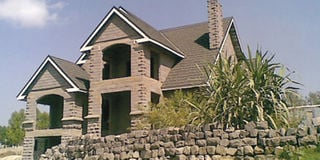Instead of building, why not buy?

Of immense importance is the value of the property, restrictions on the title, zoning of the land on which the house stands, and whether its construction was sanctioned by the local authority — in which case it should have an occupation certificate. Photo/FILE
We have been discussing what to take into consideration when building your own home.
But, suppose you decide to buy an already built house, what are the important things to do consider before committing your funds?
Before one buys a house, whether old, newly built or in the construction stage, there are very important things to do, check and consider.
For most people, this is the biggest investment they will ever make, so a pragmatic approach to the whole process, especially on issues regarding the structural integrity of the building, any defects and any potential problems, access, is important.
Also of immense importance is the value of the property, restrictions on the title, zoning of the land on which the house stands, and whether its construction was sanctioned by the local authority — in which case it should have an occupation certificate.
Get a professional valuation and survey of the location before making the decision to buy. And, once you have settled on the location, do not be bogged down by shopping around for the house those suits you.
Once satisfied that you have found your desired home, zero in on the house itself to establish its structural integrity and functionality.
Indeed, before you sign a sale and purchase agreement, make it conditional that you have to be furnished with a satisfactory house inspection certificate, handed a title search and given local authority details on the house.
Inspecting your potential home with a professional who understands buildings is most advised because certain defects are not easily detected.
Here’s a check list for consideration in regard to old houses.
1Structural integrity: The structural integrity of a building is very important as this is a matter of life and death.
Check out for cracks that extend from the foundation to the top of the building as these could be a pointer to differential settlement, which means some part of the building is sinking, thus shearing at the point of difference.
Such structural defects are difficult to rectify as the problem stems right at the foundation. Check if the building has a ring beam. These are used to span openings such as doors and windows as well as to tie the building together structurally.
2Roof: Check for any sagging, leakages and whether the timber trusses are infested with termites. Are the gutters functional. A highly neglected house will have gutters that are full of soil.
Check out for broken ridges and tiles in cases where the roofing material is concrete or clay. If it is galvanised sheets, rust will indicate a due date for re-roofing.
3Plumbing: Check whether water closets, wash hand basins, kitchen sinks and bath tubs are functioning properly — and without leakages and blockages.
Is an overhead cold water storage installed? If it is, check out for leakages and the overflow pipe to ascertain that the ball valve, usually inside the tank, is working.
The same, diligent inspection of electrical installations is also very important. A neglected building affects its overall integrity, as well as your safety when you move in.
4Finishes: Check the floor. If is wood parquet, look out for signs of termite infestation. If infested, that means the building was not treated properly against termites, and that mean your doors, windows, wardrobes and cupboards will be food to the pests.




